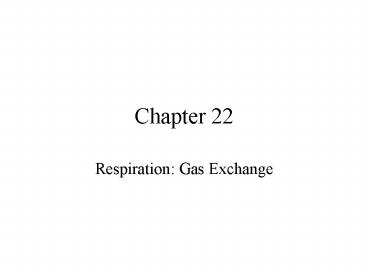Respiration: Gas Exchange - PowerPoint PPT Presentation
1 / 11
Title:
Respiration: Gas Exchange
Description:
The inner surface of the alveoli is the respiratory surface ... through the single layer of cells into the capillaries around each alveolus ... – PowerPoint PPT presentation
Number of Views:298
Avg rating:3.0/5.0
Title: Respiration: Gas Exchange
1
Chapter 22
- Respiration Gas Exchange
2
Gas Exchange
- Includes breathing, transport of gases, and gas
exchange at cellular level - Take in oxygen from air, transport it to cells
through blood, deliver to cells for cellular
respiration (production of ATP) - Cells release carbon dioxide, transported to
lungs, release to air.
3
Respiratory Surfaces
- Gas exchange occurs at moist tissues
- Gasses are dissolved in water to pass through
membranes - Large amount of surface area is necessary
- Single layer of cells for exchange
- May be skin, gills, trachae, lungs
4
Human Respiratory System
- Air enters through the nostrils, flows through
the nasal passages to be warmed and humidified - The air passes through the pharynx to the larynx
(voice box) - Air passing the vocal cords produces sounds
- The air then passes through the trachea and into
the bronchi, bronchioles and alveoli
5
Gas Exchange in Lungs
- The inner surface of the alveoli is the
respiratory surface - Oxygen passes through the single layer of cells
into the capillaries around each alveolus - Carbon dioxide diffuses in the reverse direction-
from the blood through the respiratory surface to
the air
6
Breathing
- Includes inhalation and exhalation
- Pull air in by expanding chest cavity
- Ribs move out diaphragm moves down
- Decreases pressure inside relative to outside
- Air moves in
- Reverse occurs in exhalation
- Maximum amount of air exchanged is vital capacity
7
Breathing Control
- Breathing control centers in brain regulate
normal breathing and coordinates breathing and
need for gas exchange - Breathing is regulated by CO2 level in blood
- CO2 decreases pH of blood (acidic)
- Metabolism increase? increase in CO2
- Acidity leads medulla to increase breathing rate
- Hyperventilating decreases CO2
- Oxygen has less effect on breathing than CO2
8
Gas Transport
- Blood transport the respiratory gases (O2 and
CO2) - Oxygen enters blood from alveoli
- O2 attaches to hemoglobin of red blood cells
- O2 leaves blood and enters tissue cells
- Carbon dioxide leaves tissue cells and enters
blood and is transported as carbonic acid - CO2 leaves blood in alveoli
9
Fetal Gas Exchange
- Fetal gas exchange occurs across the placenta
- O2 from mothers blood diffuses across placenta
into fetal circulation - Lungs function after birth
10
Smoking
- Smoking damages lung tissue (alveoli)
- Respiratory system is protected by mucus,
ciliated cells, and macrophages - Remove pollutants and irritants
- Chemicals in tobacco smoke irritates cells lining
trachea and bronchi - Interferes with normal cleansing
- Leads to many diseases
- Quitting smoking can reverse damage
11
- Smoking causes lung cancer and contributes to
heart disease
- Smoking also causes emphysema
- Cigarette smoke makes alveoli brittle, causing
them to rupture - This reduces thelungs capacity for gas exchange
Figure 22.7A, B































